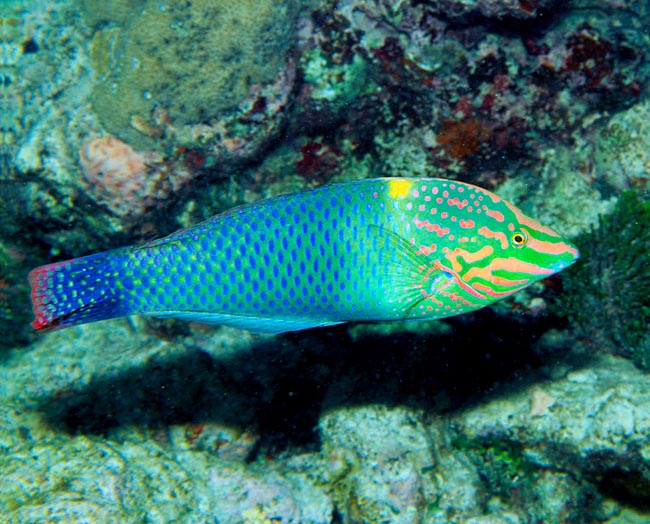Family : Labridae

Text © Giuseppe Mazza

English translation by Mario Beltramini

By night and if endangered, Halichoeres hortulanus disappears under the sand © Giuseppe Mazza
The name of the genus comes from the Greek “hals” = sea, salt, and “choiros” = piglet, because it stands among the biggest wrasses and when it stumbles into the nets is consumed by the local people.
The name of the species “hortulanus” = gardener in Latin, refers to the fact that often it turns up the sand and the fragments of coral, ploughing the bottom while looking for preys.
Zoogeography
It has a very vast distribution in the tropical waters of the Indian and Pacific oceans.
We find it, indicatively, from South Africa up to the Red Sea and the Arabic Sea, at the Seychelles, Mauritius, Réunion, Maldives, in India, Sri Lanka, Thailand, Australia, Indonesia, New Guinea, Micronesia, Philippines, Taiwan and China up to southern Japan. Eastwards, it has colonized Kiribati, Tonga, Samoa, Marquesas Islands and Tuamotu. Southwards, in the Pacific, it reaches the Great Barrier Reef and the New Caledonia.
Ecology-Habitat
It lives in calm and shallow waters, never under the 30 m of depth, in the lagoons, the seagrass meadows and the madreporic formations.
Morpho-physiology
It can reach the 27 cm. The body is fusiform, compressed on the sides, with pointed snout. Robust lips, as the family requires, and conical teeth arranged on only one row, more developed in the fore part of the mouth for catching and breaking the shells and the cuirasses of the preys. The dorsal fin is unique, with 9 spiny rays and 11 soft; the anal, shorter, shows 3 spiny rays and 11 soft; the two ventral and the pectoral ones are unarmed and the caudal is truncated.
The livery, quite variable depending on the zone, the age and the sex, has the following characteristic tracts: a series of pink stripes on the head, broken after the eye, ending in small dots; a showy yellow spot on the back at the beginning of the dorsal fin; and a blue or black checquered drawing in the second half of the body. The background colour is greenish and the final part of the tail, initially blue with pale small dots, is often red.
Ethology-Reproductive Biology
The checkerboard wrasse nourishes of gastropods, bivalves, crustaceans and sea urchins. It lives solitary and by night, or in case of danger, it disappears in a flash under the sand.
It is a protogynous hermaphroditic species, which means that the juveniles are all females and may be later on transform into males. Also thanks to this fact, the populations, decimated by the events are capable to double their number in less than 15 months, and seen that this is a species having very various alimentation, therefore insensitive to the degradation of the reefs, being too cumbersome for the domestic aquaria and little fished for alimentary purposes, it has a very low vulnerability index: just 21 on a scale of 100.
Synonyms
Hemitautoga centiquadrus Lacépède, 1801; Labrus hortulanus Lacépède, 1801; Labrus centiquadrus Lacépède, 1801; Halichoeres centiquadrus Lacépède, 1801.
→ For general information about FISH please click here.
→ For general information about BONY FISH please click here
→ For general information about CARTILAGINOUS FISH please click here.
→ To appreciate the BIODIVERSITY of BONY FISH please click here.
→ To appreciate the BIODIVERSITY of CARTILAGINOUS FISH please click here.
